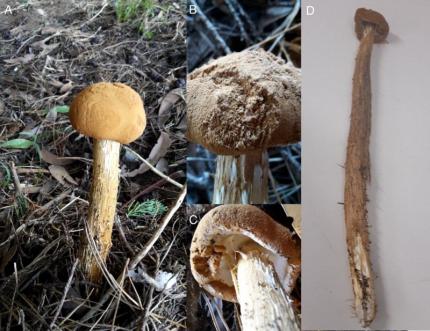News
Published 12 April 2018Unusual fungi reported in New Zealand Journal of Botany
First record of the fungus Battarrea phalloides (Agariacaceae) in New Zealand is included in Volume 56, Issue 1 of the New Zealand Journal of Botany
An article by Lara D. Shepherd of Te Papa and Jerry A. Cooper of Landcare Research Ltd. titled "First record of the fungus Battarrea phalloides (Agariacaceae) in New Zealand" is included in the latest New Zealand Journal of Botany.
On 9 May 2017, a stalked puffball fungus was found adjacent to the road on the ridgeline of Mt Victoria, Wellington (−41.302°S, 174.791°E) underneath a macrocarpa. It was the first ever recorded instance of Battarrea phalloides found in New Zealand.

Image from Lara D. Shepherd & Jerry A. Cooper, NZJB V56 Issue 1
Often described as resembling a puffball on a tall, shaggy stick, Battarrea phalloides has many colloquial names: sandy stiltball, tall stiltball, mallee drumstick, or sandy stilt puffball.
It is a distinctive saprotrophic fungus, easily recognisable with a stem up to 40 cm long and spores on the upper surface of the cap.
The specimen discovered in Wellington was unusual, as the fungus is thought to typically grow in arid, sandy conditions. Due to its distinctiveness, it is unlikely to have been overlooked by previous mycology surveys, but instead be a recent introduction.
It is likely that it arrived via wind-born dispersion - possibly the same westerly flow that infected New Zealand with myrtle rust, although the origin of the fungi remains uncertain.
You can read more about Battarrea phalloides along with other fascinating articles in the New Zealand Journal of Botany at Taylor and Francis online.
About the Journal
The New Zealand Journal of Botany aims to disseminate peer-reviewed research relevant to the botany, mycology, and phycology of New Zealand and the southern hemisphere.
The journal welcomes submissions relevant to all aspects of the botany, mycology, and phycology of the South Pacific, Australia, South America, and Southern Africa. The journal’s subject matter encompasses biosystematics and biogeography, ecology, physiology, biochemistry, genetics, reproductive biology, structure and development, taxonomy, ethnobotany, palaeobotany, bryology, lichenology, mycology, plant pathology, and phycology.
